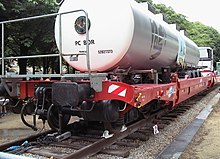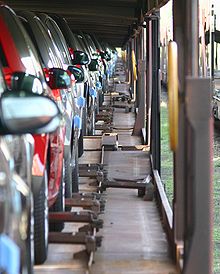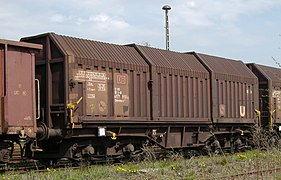|
Flat wagon
 Flat wagons (sometimes flat beds, flats or rail flats, US: flatcars), as classified by the International Union of Railways (UIC), are railway goods wagons that have a flat, usually full-length, deck (or 2 decks on car transporters) and little or no superstructure. By contrast, open wagons have high side and end walls and covered goods wagons have a fixed roof and sides. Flat wagons are often designed for the transportation of goods that are not weather-sensitive. Some flat wagons are able to be covered completely by tarpaulins or hoods and are therefore suitable for the transport of weather-sensitive goods. Unlike a "goods wagon with opening roof", the loading area of a flat is entirely open and accessible once the cover is removed. Flats form a large proportion of goods wagons; for example in 1998 they comprised 40% of the total goods fleet owned by the German carrier, DB, the overwhelming majority of which were flat wagons with bogies. Typical goods transported by these railway wagons are: vehicles, engines, large pipes, metal beams, wire coils, wire mesh, half-finished steel products, (sheets, coils, pipes, bars and plates), containers, rails, sleepers and complete sections of railway track. Gravel, sand and other bulk goods are transported on flat wagons with side panels. International UIC classification Flat wagons are classified by the UIC into:
The main difference between the ordinary and special types of flat wagon is that the former always have to have a flat deck that can be driven on, whereas the special types do not have to be so designed. Within both types of flat wagon, there are variants with separate axles as well as bogie wagons. In addition numerous other terms are used to classify flat wagons according to their purpose, but without clear and comprehensive specifications. UIC standard goods wagonsAttempts by the International Union of Railways (UIC) to standardise flat wagons go back to the 1950s. These efforts led to the establishment of characteristics for so-called "standard wagons". Standardised flat wagons are specified in the following UIC pamphlets:
The implementation of these guidelines is partly binding and partly voluntary for members of the UIC. Since the end of 1977, flat wagons that partially conform to these guidelines are identified by the designation "UIC". Flat beds that comply fully with the leaflets, and are therefore true UIC standard wagons, are given the designation "UIS St". K: Ordinary two-axle flat wagonsThe Class K flats were originally one of the largest families of goods wagons, not least in Germany, thanks to the many older type stake wagons (stanchion wagons) that were assigned to it. The bulk of their work has since been taken over by special flat wagons. By 1998, DB only had 10,000 of this type left. The majority of ordinary two-axle flat beds built since the 1950s were those with folding sides and short swivelling stanchions of UIC type 1 with, at least in Germany, an axle base of only 8 metres (26 ft 2+15⁄16 in). 
In recent years new K wagons have been developed. These have fixed ends and a tarpaulin cover and are therefore also suitable for hygroscopic goods. Their designation is Kils, based on the UIC classification of goods wagons. In addition to the normal letters indicating length and weight (k, kk, n, m and mm) the Type K may also have the following index letters:
  L: Special flat wagons with separate axlesToday this class contains:
Only of historic significance, by contrast, are pod wagons (see below) and cradle wagons (see below). As a rule, L wagons do not have stanchions. The most important index letters for basic classification of current types are:
The UIC has standardised three types of L wagon, the Class Lgss being based heavily on the Class Ks (see above):
O: Mixed open flat wagonsThe standard mixed open flat wagon group has folding sides, stanchions and two or three axles. The most important index letters for this group are:
The dimensions of the UIC standard wagon largely conform to the considerably more common Class Ks wagon (see above):
R: Ordinary flat wagons with bogies  .  The exclusively four-axle bogie wagons of Class R are equipped with a solid, level deck, usually made of wood, and, unless indicated otherwise by the code letters, also furnished with stanchions and end walls. Most types have short, removable, swivelling stanchions. They are especially suited to the transport of long steel elements, building materials, machines and large vehicles. In the 1990s, the DB purchased Class R wagons with long, sturdy, light metal stanchions and high end walls for the increasing amount of log transport required. In 1998, the DB had about 17,000 R wagons in service. The most important index letters for distinguishing the basic types are as follows:
The UIC has specified two standard R wagons, both of which are very common e.g. in Germany. In the mid-1970s there was a switchover to newly built wagons with foldable sides.
S: Special flat wagons with bogies
This is the largest group of flat wagons both in terms of variety and numbers. Their classification as special wagons arises either as a result of not having a wagon deck that is drivable or due to their axle count. Unlike the standard wagons, these flats are predominantly optimised for a specific purpose. In 1998 the DB had about 22,000 Class S wagons in its fleet. The large variety of variants may be seen from the number of index letters, of which only the most important are given here; i.e. those that are needed to distinguish the basic types:
S wagons for heavy loads  These wagons are so designed that the loading is limited only by the class of railway line, not the wagon itself. In order to keep the sag as low as possible, they are relatively short and thus mainly inscribed with the index letters mm. The six-axle wagons with drivable decks of class Samm… are similar to the four-axle Rmm wagons, but are grouped with this special class due to the number of axles. In the Deutsche Bahn, these mainly consist of RRym wagons with a 90-tonne (89-long-ton; 99-short-ton) payload. In considerably larger numbers, and designed for transporting steel coils, are the four and six-axle wagons equipped with loading troughs of the class S…hmm…. Some have fixed end walls and removable covers in the shape of tarpaulins or telescopic hoods. The Shimmns708 serving with the DB, which is the most common German S wagon, has an unladen weight of about 23 t (23 long tons; 25 short tons) and a loading limit of 67 t (66 long tons; 74 short tons) and is thus able to carry coils with a total weight of about 45 t (44 long tons; 50 short tons). The UIC has standardized a four and a six-axle telescopic hood wagon for the transport of coils. Such wagons have been used in Germany since the 1970s and 1980s respectively, but usually fitted with (light) tarpaulins instead of the hoods:
S wagons for combined transportThe group known as wagons for combined transport have specific designs and equipment for the transport of the various transport units. The UIC has standardized several wagons, whose most important dimensions are given in the following table:
Flat wagons for ISO containers and swap bodiesThese wagons of Class Sg… are most common in combined transport. Their foldable trunnions (klappbare Tragzapfen) make them suitable for various transport systems. Some of these rail vehicles are equipped with long-stroke shock absorbers (index letter j) as special equipment for the protection of loads.
The use of Kangourou wagon and Wippenwagen remained restricted in the period from the 1960s to the 1980s, despite their utility in enabling horizontal cross-loading without cranes, because at that time facilities for swap body cross-loading were still widely available in western Europe. The CargoSprinter, conceived as a goods wagon for the transport of ISO containers, did not get any further than trials. ACTS wagonsThese wagons for the ACTS roller container transport system with horizontal crossloading are common especially in Switzerland and the Netherlands. The Swiss wagons bear the national index letter x.  Flat wagons for road vehiclesFlat wagons for road vehicles (Class S…d…) are less common, because this typ of combined transport is only efficient on certain routes.
S wagons for special purposes For the transport of logs, four-axle wagons with non-drivable decks and equipped with high, fixed stanchions are used (Class Snps). Wagons with a flat deck for transporting assembled track sections, some of which are fitted with special equipment and used in maintenance of way trains, are usually classified as departmental wagons. Under some circumstances bucket wagons (Kübelwagen) are not classified as open wagons, but grouped into Class S. The group known as Spreizhaubenwagen (Sins, Sfins) are related to the Sliding wall wagons and, like them are for hygroscopic goods, but have no fixed roof. The sliding walls taper inwards towards the top and are connected by an articulated joint so the walls can be spread and slid apart, so that one half of the wagon is entirely open and may be loaded or unloaded from the side by forklift truck or from above by crane. Flat wagons for specific purposes that are grouped under several classesContainer wagons Container wagons are flats specially fitted with securing equipment for transporting ISO containers. Depending on their design they may be grouped into classes L, R or S. Class K wagons are rarely used because even an 8-foot (2.438 m) high ISO container exceeds the European loading gauge. The presence of container pins is always indicated by the index letter g. Only general purpose wagons that have to be specially prepared for container transport and have a drivable floor, are classed as standard wagons. Wagons that are exclusively used for container transport are classified as special types. In the latter case, the profile of the wagon underframe is left open and the container only rests on the beams and the trunnions. Most container flats are designed to take standard 20 and 40 foot ISO containers. Two-axle wagons of this type are able to carry two 20-foot or one 40-foot container; many four-axle wagons have room for three 20-foot or one 40-foot and one 20-foot container. In India double stacking of containers is done on flat wagons instead of well cars under 7.5m high catenary because the wider Indian Gauge permits more height while keeping the centre of gravity still low.[6] Car transporters Car transporters (US: autoracks) are predominantly used for the delivery of factory-new cars and vans to dealers. Because cars are a relatively light form of freight, European car transporters have two decks and, despite their great length, only need at most three axles. Where there are three axles, the centre one rests on a swivel and the wagon has an articulated joint in the middle. The cars can be loaded over the joint. These wagons are open as a rule and are thus classified as flat wagons of Class L (see above). Before the development of these specials, standard open wagons were fitted with a second deck, the end walls were removed and pairs of wagons were permanently coupled in order to be used as car transporters. In Germany in the 1950s their capacity proved no longer sufficient for the transport of the VW Beetle. As a result, engineers at Volkswagen and Deutsche Bundesbahn jointly designed an extra long wagon for the transport of factory-new vehicles. The result was a wagon that could carry ten cars from the factory to the ports for export from 1958 onwards. The car-carrier wagons used in motorail trains are not classed as goods wagons despite their similar design. See alsoReferences
Literature and sources
External linksWikimedia Commons has media related to Flat wagons. Wikimedia Commons has media related to Coil wagons. Wikimedia Commons has media related to Container wagons. Wikimedia Commons has media related to Car transporters. |
||||||||||||||||||||||||||||||||||||||||||||||||||||||||||||||||||||||||||||||||||||||||||||||||||||||||||||||||||||||||||||||||||||||||||||||||||||||||||||||||||||||||||||||||||||||||||||||||||||||||







